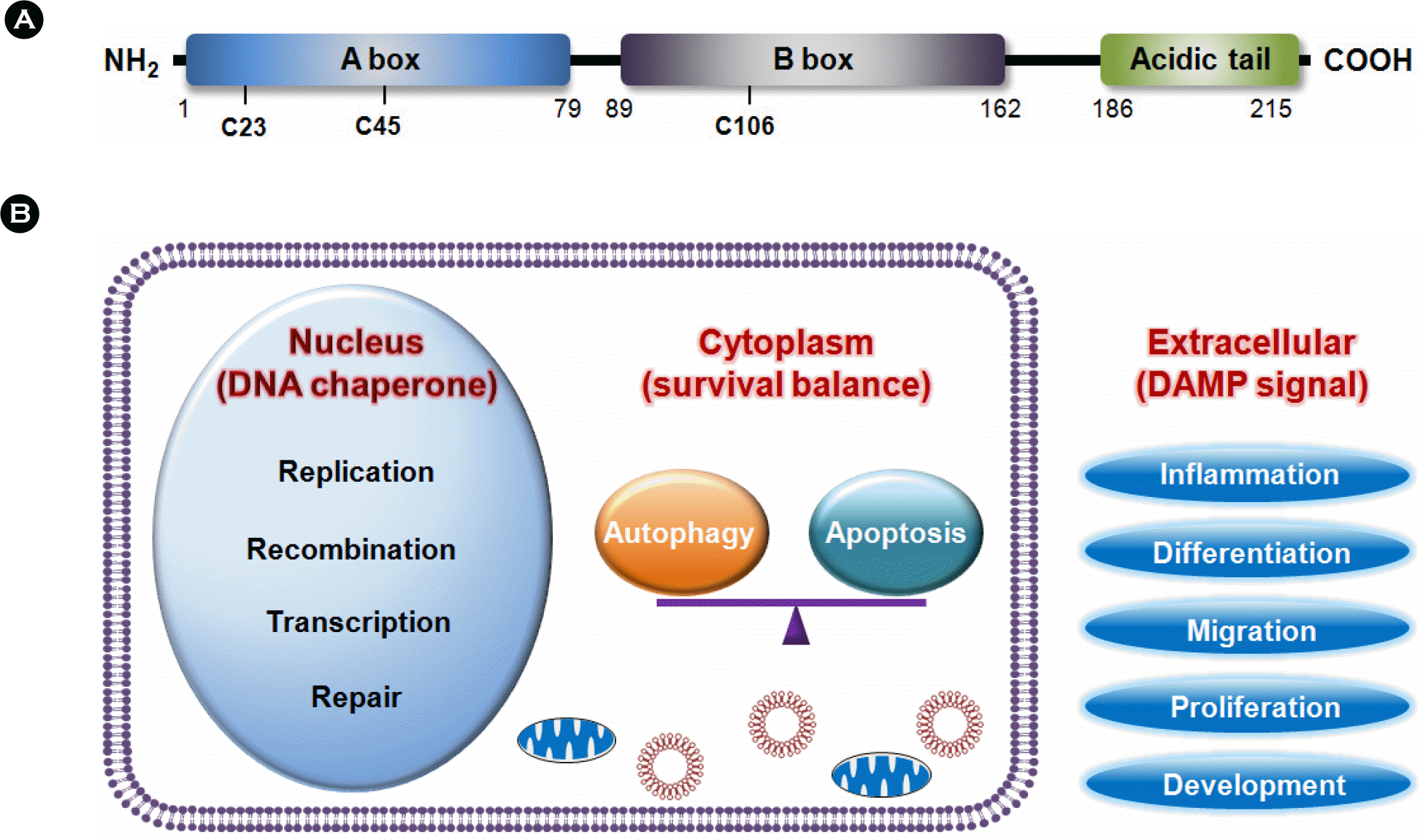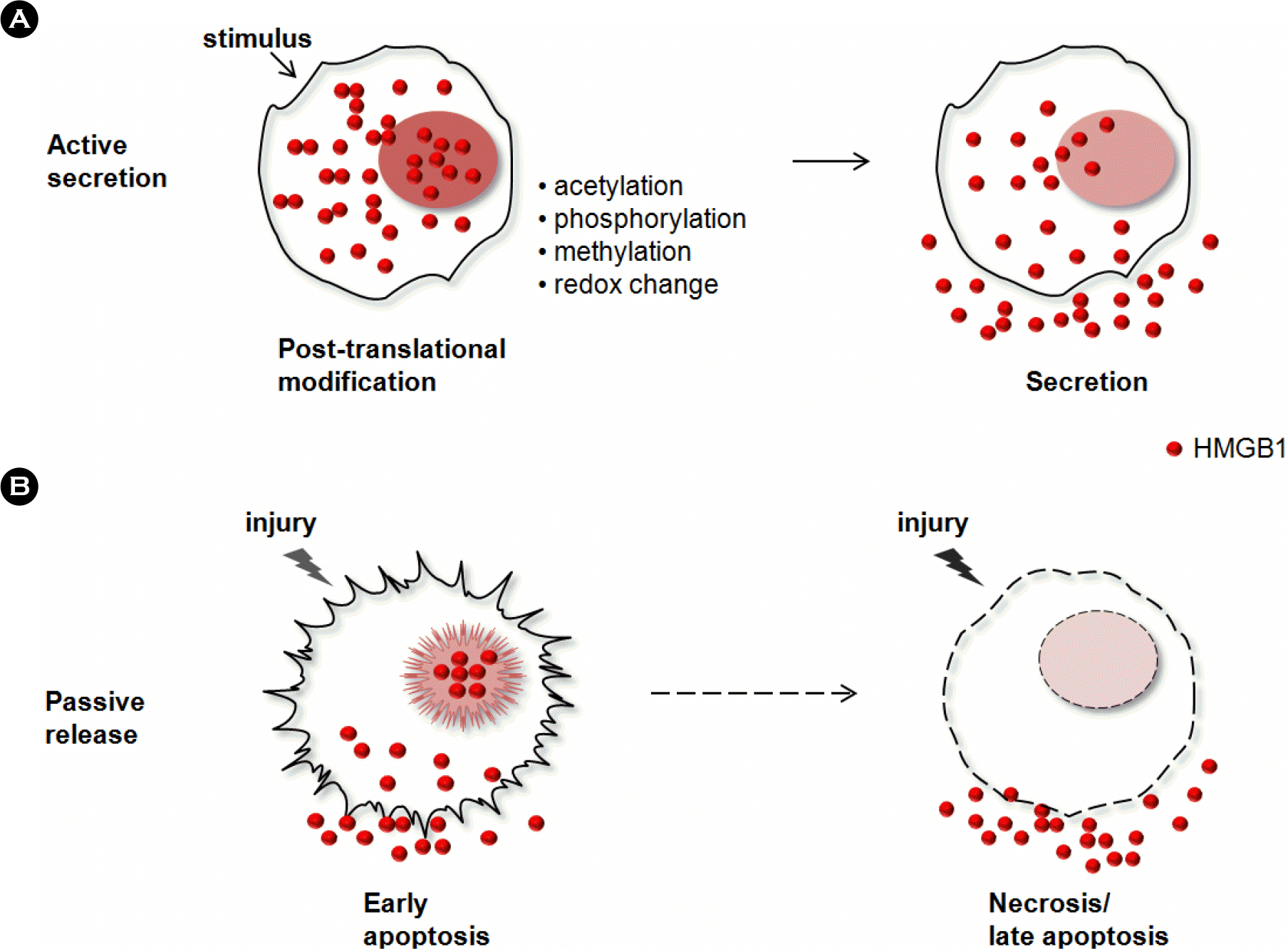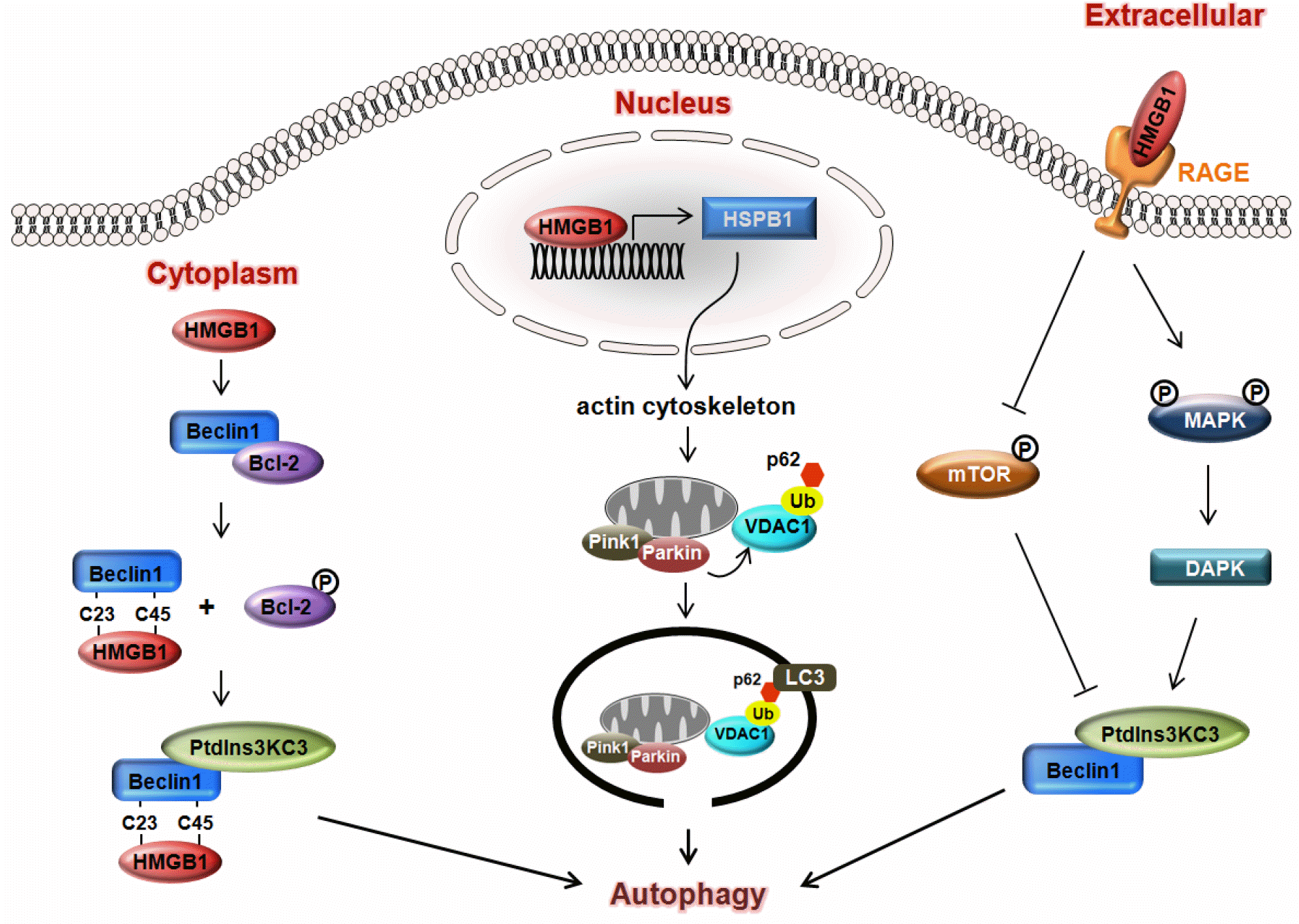Abstract
Reactive oxygen species (ROS) is an oxidative stress to which cells respond by activating various defense mechanisms or cell death. Autophagy associated with oxidative stress response is a process to degrade and recycle macro-molecule as well as organelles in eukaryotic cells. HMGB1, a ubiquitous nuclear protein, is actively released in eukaryotic cells under oxidative stress. HMGB1 plays an important role as regulator of autophagy in nuclear, cytosolic and extracellular level. Nuclear HMGB1 regulates the expression of heat shock protein β-1 (HSPB1), which is critical for dynamic intracellular trafficking during autophagy and mitophagy. Cytoplasmic HMGB1 can bind to a beclin 1 by the intramolecular disulfide bridge using cysteine 23 and 45, which dissociates its inhibitory partner Bcl-2 and induces autophagy. Extracellular HMGB1 binds to receptor for advanced glycation endproducts (RAGE) which inhibits mammalian target of rapamycin (mTOR) and then promotes the formation of the belin1-Ptdlns3KC3 complex. Furthermore, endogenous HMGB1 is an intrinsic regulator of autophagy, and it enhances chemoresistance in diverse cancer cells. Here, we review recent reports suggesting a novel mechanism of diverse cancer cell resistance to therapy facilitated by HMGB1-mediated autophagy.
Go to : 
REFERENCES
1). Demple B, Amábile-Cuevas CF. Redox redux: the control of oxidative stress responses. Cell. 1991; 67:837–9.

2). Grune T, Merker K, Sandig G, Davies KJ. Selective degradation of oxidatively modified protein substrates by the proteasome. Biochem Biophys Res Commun. 2003; 305:709–18.

3). Kiffin R, Bandyopadhyay U, Cuervo AM. Oxidative stress and autophagy. Antioxid Redox Signal. 2006; 8:152–62.

5). Stott K, Watson M, Howe FS, Grossmann JG, Thomas JO. Tail-mediated collapse of HMGB1 is dynamic and occurs via differential binding of the acidic tail to the A and B domains. J Mol Biol. 2010; 403:706–22.

6). Hoppe G, Talcott KE, Bhattacharya SK, Crabb JW, Sears JE. Molecular basis for the redox control of nuclear transport of the structural chromatin protein Hmgb1. Exp Cell Res. 2006; 312:3526–38.

7). Tang D, Kang R, Zeh HJ 3rd, Lotze MT. High-mobility group box 1 and cancer. Bioichim Biophys Acta. 2010; 1799:131–40.

8). Bonaldi T, Talamo F, Scaffidi P, Ferrera D, Porto A, Bachi A, et al. Monocytic cells hyperacetylate chromatin protein HMGB1 to redirect it towards secretion. EMBO J. 2003; 22:5551–60.

9). Youn JH, Shin JS. Nucleocytoplasmic shuttling of HMGB1 is regulated by phosphorylation that redirects it toward secretion. J Immunol. 2006; 177:7889–97.

10). Oh YJ, Youn JH, Ji Y, Lee SE, Lim KJ, Choi JE, et al. HMGB1 is phosphorylated by classical protein kinase C and is secreted by a calcium-dependent mechanism. J Immunol. 2009; 182:5800–9.

11). Ito I, Fukazawa J, Yoshida M. Post-translational methylation of high mobility group Box 1 (HMGB1) causes its cytoplasmic localization in neutrophils. J Biol Chem. 2007; 282:16336–44.

12). Tang D, Kang R, Xiao W, Jiang L, Liu M, Shi Y, et al. Nuclear heat shock protein 72 as a negative regulator of oxidative stress (hydrogen peroxide)-induced HMGB1 cytoplasmic translocation and release. J Immunol. 2007; 178:7376–84.

13). Lamkanfi M, Sarkar A, Vande Walle L, Vitari AC, Amer AO, Wewers MD, et al. Inflammasome-dependent release of the alarmin HMGB1 in endotoxemia. J Immunol. 2010; 185:4385–92.

14). Scaffidi P, Misteli T, Bianchi ME. Release of chromatin protein HMGB1 by necrotic cells triggers inflammation. Nature. 2002; 418:191–5.

15). Bell CW, Jiang W, Reich CF 3rd, Pisetsky DS. The extracellular release of HMGB1 during apoptotic cell death. Am J Physiol Cell Physiol. 2006; 291:1318–25.

16). Kang R, Livesey KM, Zeh HJ 3rd, Lotze MT, Tang D. Metabolic regulation by HMGB1-mediated autophagy and mitophagy. Autophagy. 2011; 7:1256–8.

17). Kang R, Livesey KM, Zeh HJ, Loze MT, Tang D. HMGB1: a novel Beclin 1-binding protein active in autophagy. Autophagy. 2010; 6:1209–11.

18). Kang R, Tang D, Loze MT, Zeh HJ. Apoptosis to autophagy switch triggered by the MHC class III-encoded receptor for advanced glycation endproducts (RAGE). Autophagy. 2011; 7:91–3.

Go to : 
 | Figure 1.
The structure and function of HMGB1. (A) HMGB1 is composed of three domains: two DNA binding domains (the A and B boxes) and a negatively charged carboxyl terminus. Three cysteines are encoded at position 23, 45, and 106. (B) HMGB1 is present in almost all of eukaryotic cells. In nucleus, HMGB1 plays roles in the DNA replication, recombination, transcription, and repair. In cytoplasm, HMGB1 regulates the balance between autophagy and apoptosis. Extracellular HMGB1 mediates the response to inflammation, differentiation, migration, proliferation, and development. |
 | Figure 2.
The release of HMGB1. (A) HMGB1 is actively secreted in response to exogenous and endogenous inflammatory stimuli. This translocation is stimulated by post-translational modification. (B) HMGB1 is also passively released by necrotic or apoptotic cells death caused by injury. |
 | Figure 3.
The role of HMGB1 in autophagy. Endogenous HMGB1 competes with Bcl2-Beclin1 complex. The intramolecular disulfide bridge (C23 and C45) of HMGB1 is required for binding to beclin1 and regulate autophagosome formation. The nuclear protein HMGB1 modulates mitochondrial respiration by sustaining autophagy through the regulation of HSPB1. HSPB1 induce the actin filaments, which is involved in the dynamics of autophagy and mitophagy. Secreted HMGB1-RAGE complex sustains autophagy associated with decreased phosphorylation of the mTOR and increased beclin1-Ptdlns3KC3 interaction. |




 PDF
PDF ePub
ePub Citation
Citation Print
Print


 XML Download
XML Download